Overview
The article asserts that construction augmented reality (AR) significantly enhances project efficiency and safety through a range of innovative applications. Research indicates that AR not only improves communication but also reduces errors and enables real-time data visualization. These advancements ultimately lead to increased productivity and safer working environments in construction projects.
By adopting AR, stakeholders can transform their operations, addressing common challenges and seizing opportunities for growth. Embracing this technology is not just a trend; it is a proven strategy for success in the competitive construction landscape.
Introduction
Augmented Reality (AR) is fundamentally transforming the construction industry, providing innovative solutions that significantly enhance project efficiency and safety. As stakeholders increasingly seek ways to visualize complex designs and workflows, AR emerges as a powerful tool that not only fosters collaboration but also minimizes costly errors.
Research indicates that companies leveraging AR can reduce project timelines and improve accuracy, thus addressing common industry challenges. However, while the technology promises remarkable benefits, it also presents challenges that companies must navigate to fully realize its potential.
What proven strategies can construction firms implement to harness the advantages of AR while overcoming these obstacles? This inquiry is critical for those looking to stay ahead in a competitive landscape.
Magic Playbox: Enhancing Construction Projects with Immersive AR Solutions
Magic Playbox stands at the forefront of immersive construction AR solutions, transforming construction endeavors through real-time visualizations and interactive experiences. This groundbreaking technology empowers stakeholders to visualize intricate designs and workflows, ensuring alignment from the planning phase to execution. By enhancing communication and teamwork, AR significantly reduces the likelihood of costly mistakes, ultimately boosting efficiency across the board.
For instance, a builder named XYZ reported a remarkable 20% increase in efficiency after integrating AR into their communication processes. Furthermore, the combination of digital twin systems with AR facilitates the creation of virtual replicas of physical assets, overlaying real-time data to enhance monitoring and decision-making throughout the project lifecycle.
As the AR/VR market is projected to expand at an astonishing CAGR of 77% from 2019 to 2024, this growth underscores the critical importance of adopting immersive construction AR solutions for firms eager to redefine their workflows and achieve unparalleled precision and collaboration.
Real-Time Design Visualization: Transforming Construction Planning with AR
Augmented Reality (AR) technology is revolutionizing planning by enabling real-time design visualization, allowing teams to overlay digital models directly onto physical job sites. This innovative capability empowers stakeholders to visualize how designs integrate with existing environments, fostering improved decision-making and facilitating immediate feedback.
By identifying potential issues before they manifest, construction teams can proactively make adjustments in their construction AR processes, significantly reducing the risk of costly delays and resource wastage. The combination of construction AR with Building Information Modeling (BIM), utilizing tools like Microsoft HoloLens and Autodesk BIM 360, illustrates this benefit, enhancing accuracy and efficiency while optimizing workflows.
Furthermore, AR enhances training by overlaying real-time hazard visualizations, which improves situational awareness and reduces risks. Consequently, construction AR not only enhances teamwork among members but also ensures that construction components are positioned accurately, ultimately resulting in safer and more efficient delivery.
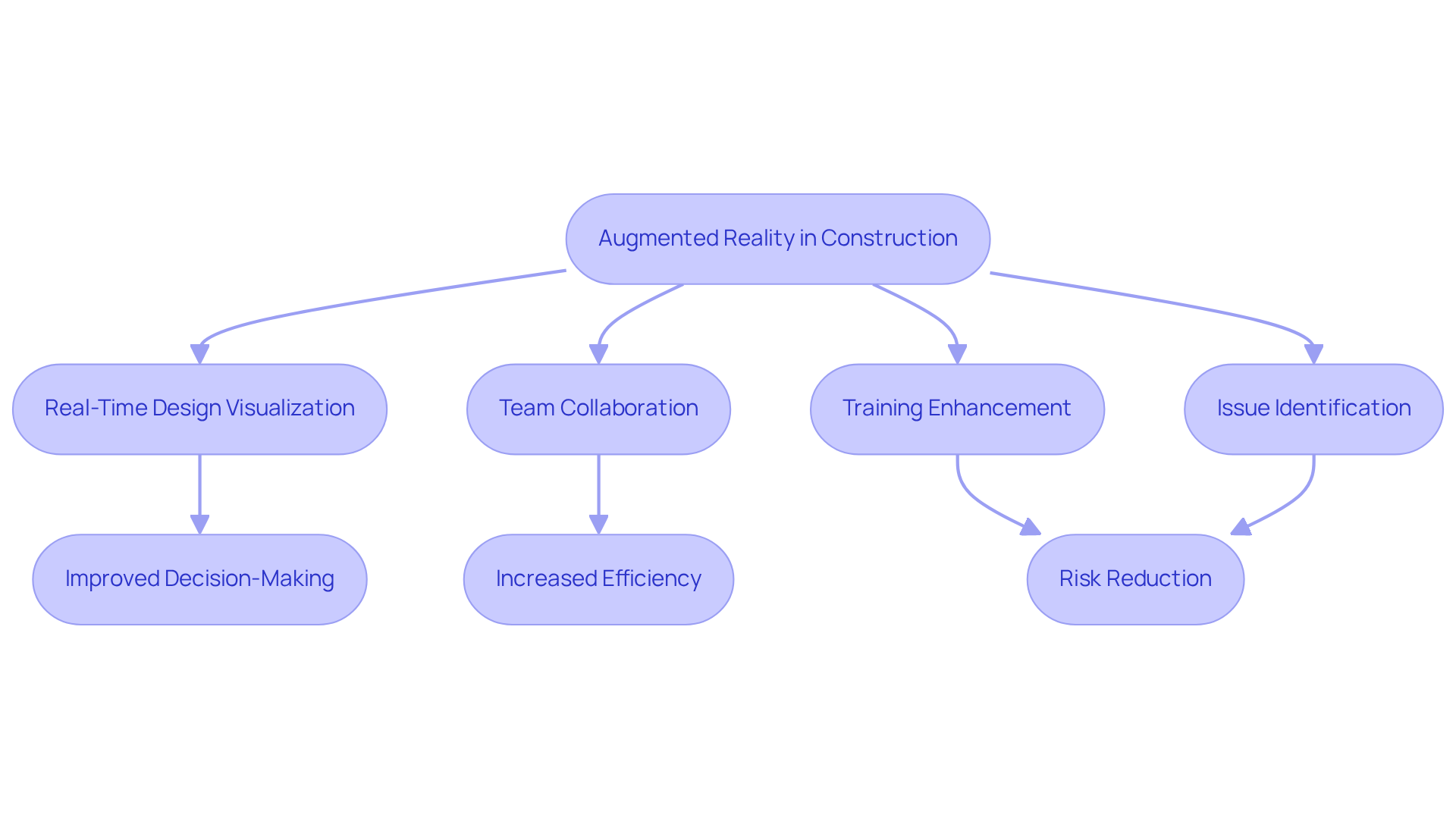
On-Site Management: Streamlining Construction Processes with Augmented Reality
Augmented reality (AR) revolutionizes on-site management by delivering real-time data overlays that include timelines, resource allocations, and safety protocols. This technology empowers managers to monitor progress and make informed decisions swiftly, thereby reducing downtime and enhancing overall efficiency.
For instance, building teams that leverage construction AR can visualize project milestones and pinpoint potential delays before they escalate, ensuring projects stay on schedule and within budget. The construction AR industry, which is responsible for structures valued at approximately $1.3 trillion annually, stands to benefit immensely from these advancements.
AR not only boosts operational efficiency but also fosters a safer work environment by providing instant access to critical information. Notably, the injury rate in the building sector is 71% higher than in any other industry, underscoring AR's vital role in enhancing safety.
Furthermore, the capacity of construction AR to minimize rework and save substantial project time accentuates its transformative influence on workflows. However, challenges such as significant upfront costs and the need for training may hinder AR adoption. It is essential for companies to consider these factors when integrating this groundbreaking technology into their operations.
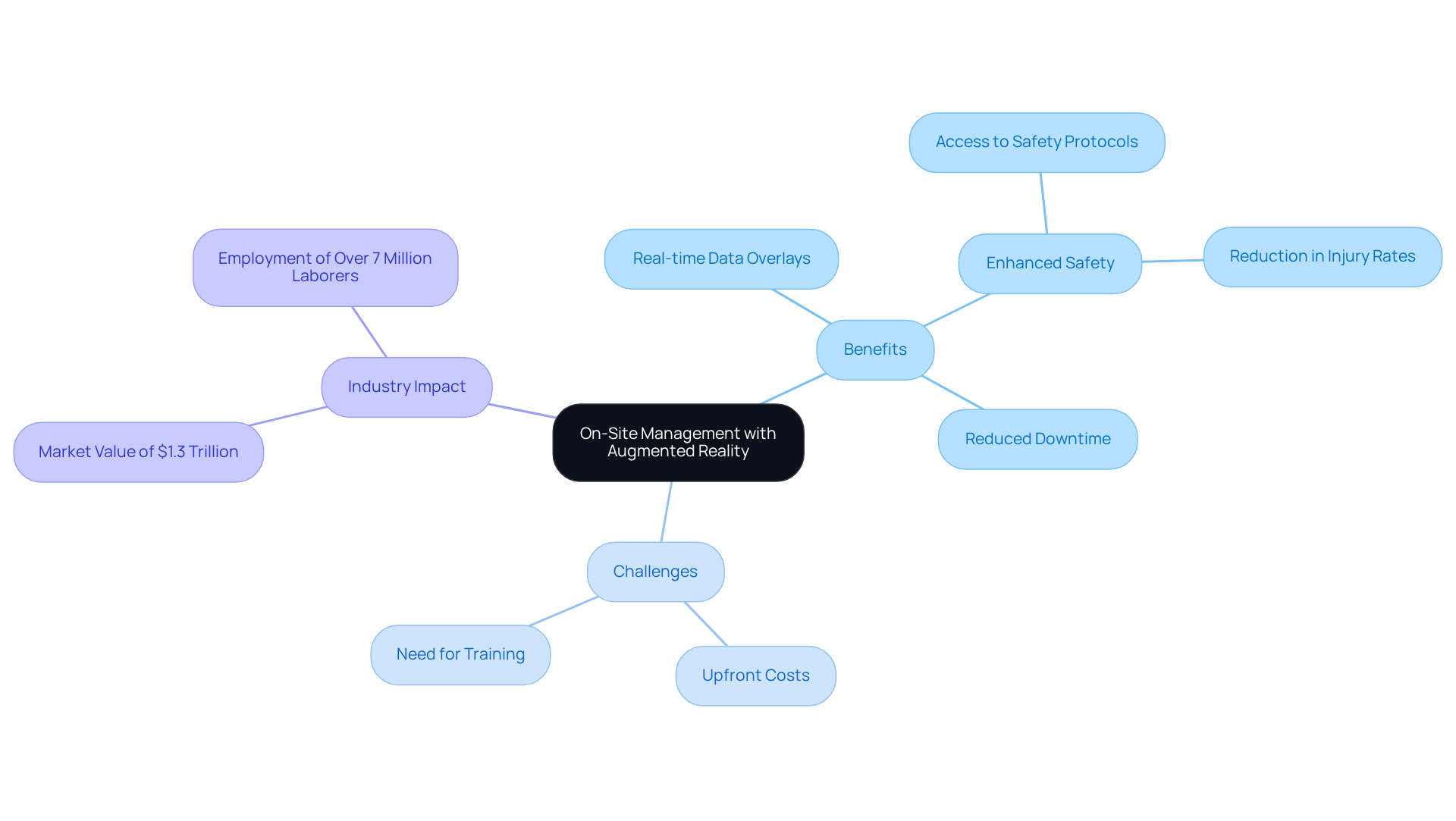
Interactive Safety Training: Using AR to Improve Worker Safety in Construction
Augmented reality (AR) revolutionizes training by delivering immersive, interactive simulations that empower workers to practice protocols within a controlled environment. This cutting-edge technology enables employees to identify potential dangers and refine their reactions, fostering a deeper understanding of procedural protocols.
Research indicates that AR training significantly enhances knowledge retention and equips employees for real-life situations, ultimately contributing to a reduction in workplace accidents. For instance, construction AR applications have demonstrated improved safety by allowing workers to engage with realistic scenarios, thus honing their skills and awareness.
By integrating AR into risk training, companies can develop dynamic learning experiences that not only educate but also empower workers to navigate high-risk environments with greater effectiveness. Furthermore, studies suggest that AR training results in a smaller decline in knowledge retention over time compared to traditional methods, underscoring its effectiveness.
With the AR/VR market projected to reach $250 billion by 2028, the significance of these technologies in workplace safety is undeniable. Additionally, AR/VR applications have positively influenced over 23 million jobs globally, highlighting their importance across various sectors.
As G. Lampropoulos notes, the integration of AR and VR in training provides individuals the opportunity to practice and refine their skills in secure virtual environments, enhancing overall learning outcomes. To maximize effectiveness, it is advisable to complement AR/VR training with traditional methods, ensuring a comprehensive approach to safety training.
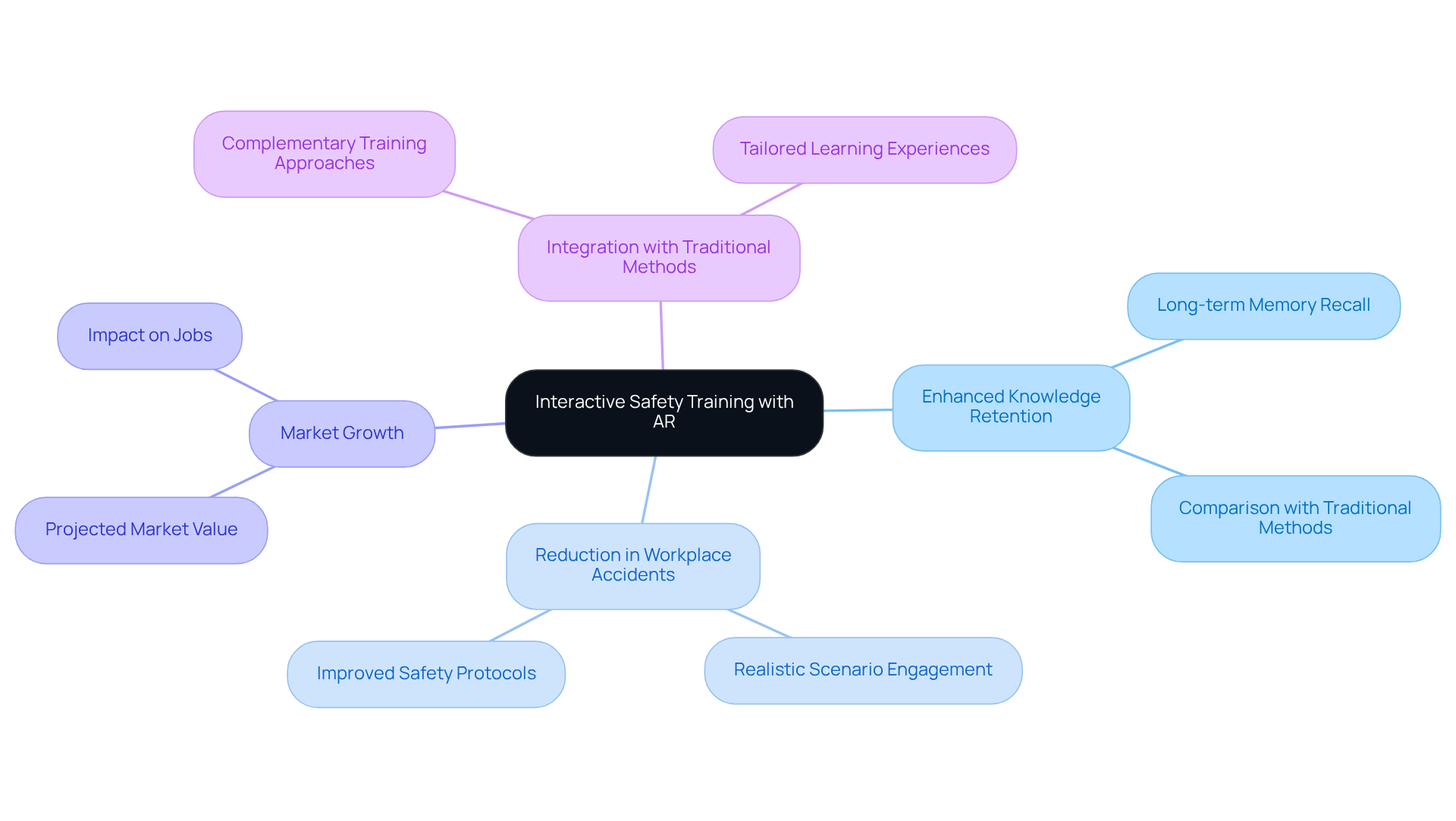
Collaborative Project Management: Boosting Team Communication with AR
Augmented Reality (AR) significantly enhances collaborative management by facilitating real-time communication and information sharing among team members, irrespective of their physical location. AR tools empower teams to visualize updates, annotate designs, and discuss changes instantly, fostering a unified working environment.
For example, Splashtop AR allows technicians to share live camera feeds with remote experts, enabling immediate visual assessments and guidance. This capability not only streamlines workflows but also reduces the likelihood of errors, with research indicating that the application of construction AR can decrease mistakes by up to 50%.
Furthermore, integrating AR with Building Information Modeling (BIM) enhances coordination, improving communication by as much as 30%. Consequently, teams can identify discrepancies early, averting costly rework and ensuring that projects align with specifications and deadlines. Improved collaboration can also result in a 41% increase in customer satisfaction, underscoring the crucial role of construction AR in contemporary construction practices.
However, it is essential to acknowledge that challenges such as high costs and the complexity of AR systems can hinder its adoption within the industry. The cumulative effect of these advancements leads to superior project outcomes, heightened productivity, and increased client satisfaction.
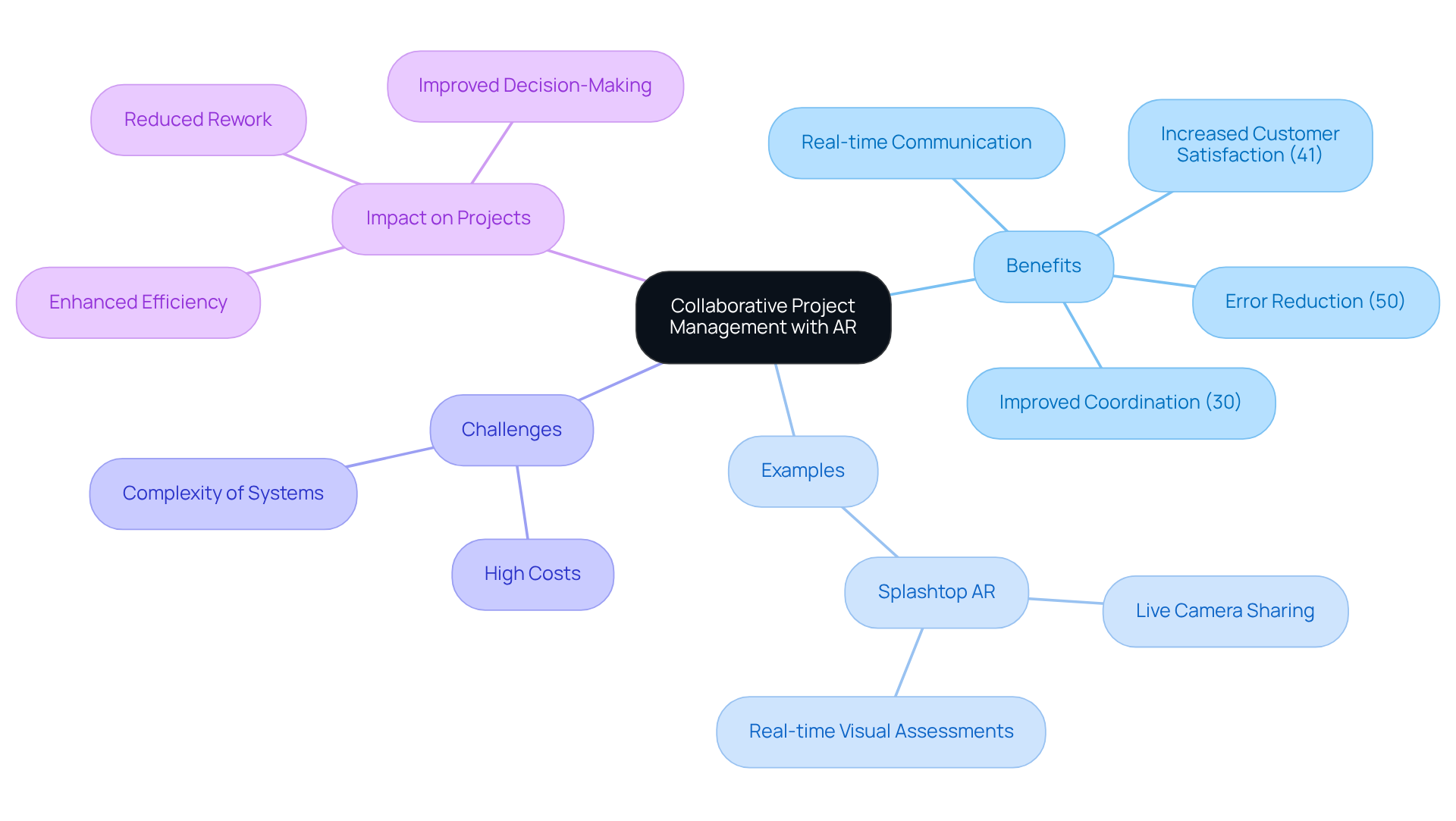
Maintenance and Repair: Leveraging AR for Enhanced Accuracy in Construction
Advancements in construction AR are revolutionizing maintenance and repair procedures within the building sector by providing technicians with real-time, context-aware information. By overlaying digital instructions and schematics directly onto physical equipment, AR empowers workers to execute repairs with heightened accuracy and efficiency. This capability significantly reduces the likelihood of errors, ensuring that maintenance tasks are completed correctly on the first attempt, thereby minimizing downtime and associated costs.
Research indicates that construction AR systems can enhance building maintenance and inspection tasks by guiding technicians to specific equipment, resulting in productivity improvements of up to 40% in activities such as electrical wiring installation. However, challenges such as interoperability between BIM systems and AR models can impede widespread adoption.
As Tim Cook emphasized, a substantial portion of the population will engage with AR experiences daily, underscoring its increasing relevance. As construction AR technology continues to advance, its integration into building workflows is expected to streamline operations, enhance safety, and ultimately transform the way maintenance and repair tasks are conducted in the industry.
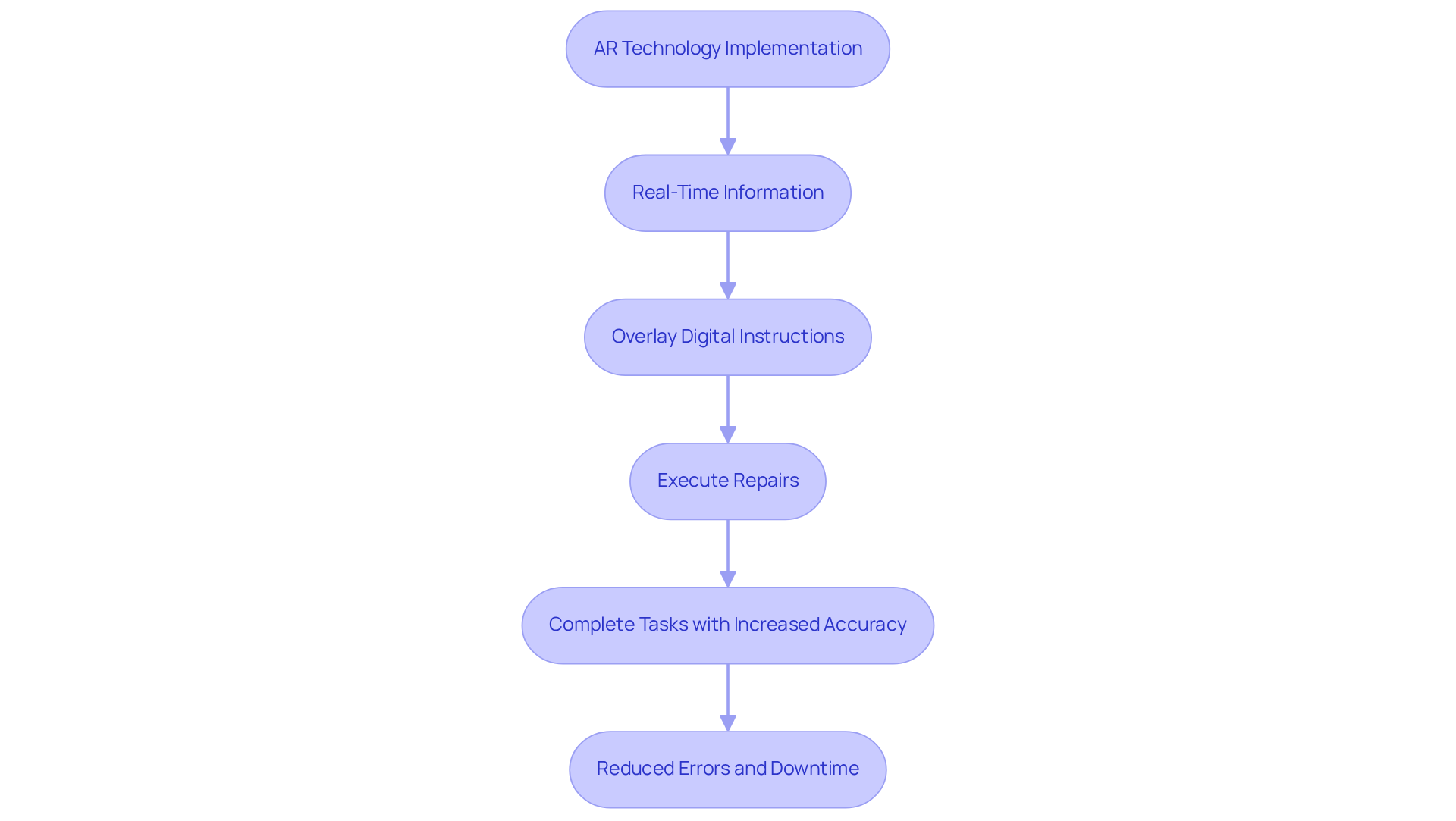
Stakeholder Engagement: Visualizing Complex Projects with Augmented Reality
Augmented reality (AR) profoundly enhances stakeholder engagement by empowering clients and investors to visualize complex construction AR projects in an immersive way. By utilizing interactive 3D models and virtual walkthroughs, stakeholders achieve a clearer understanding of designs and their implications. This immersive experience fosters trust and collaboration, ensuring that all parties remain aligned with the project's vision.
For example, construction AR tools like Microsoft HoloLens enable stakeholders to visualize 3D models on-site, which facilitates improved design comprehension and informed decision-making. Moreover, construction AR can overlay digital information onto real-world environments, assisting teams in comparing plans with actual site conditions, thereby minimizing errors and enhancing operational efficiency.
As a result, clients become more engaged and informed throughout the construction process, leading to superior outcomes and increased satisfaction.
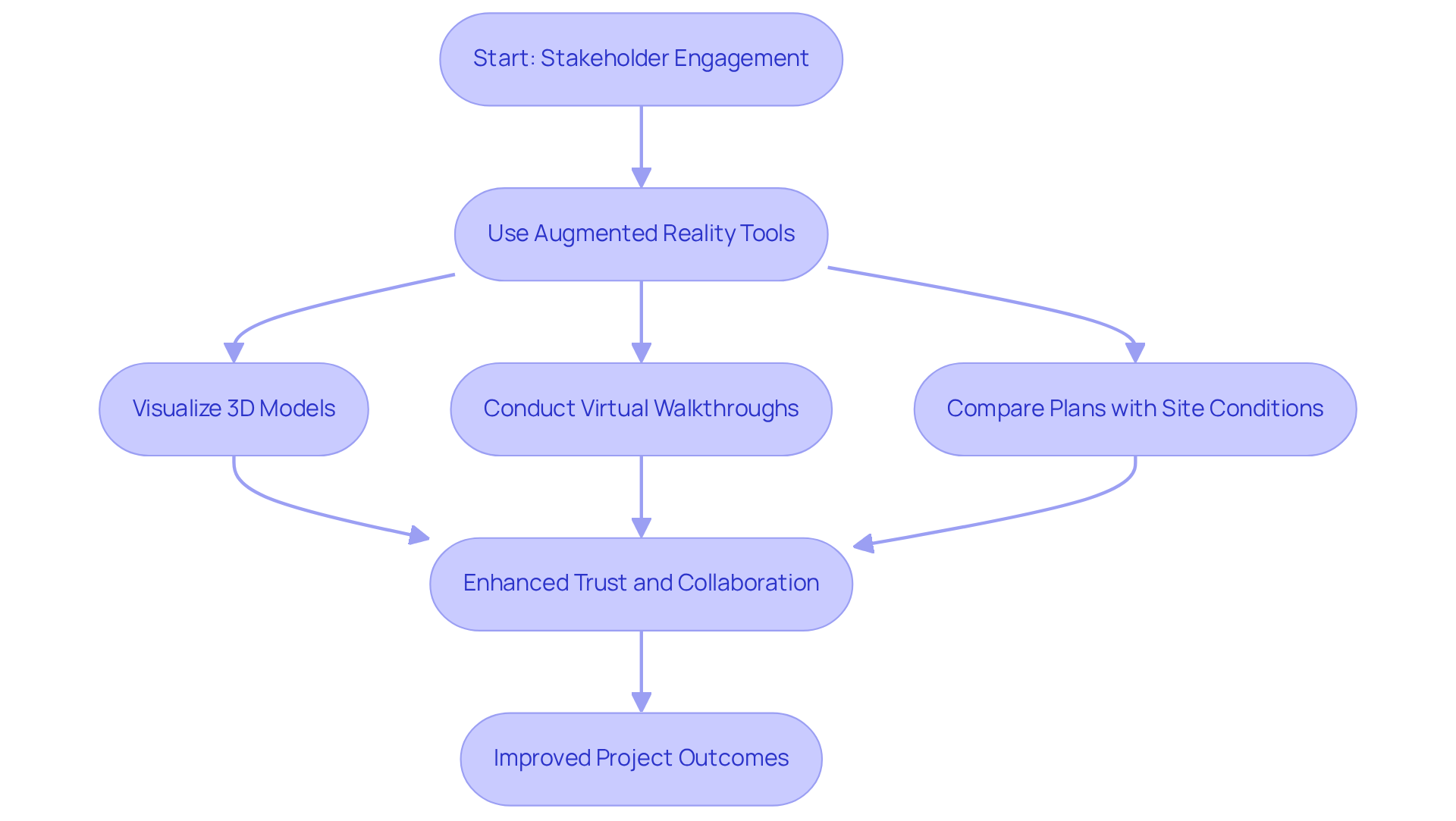
Innovative Marketing Strategies: Showcasing Construction Projects with AR
Augmented reality (AR) in construction is revolutionizing marketing strategies, enabling companies to showcase their designs in engaging and interactive ways. This innovation allows prospective clients to interact with designs through immersive experiences, effectively distinguishing companies in a competitive landscape.
By superimposing digital models onto real-world environments, AR provides clients with a tangible understanding of projects, significantly enhancing their interest and likelihood of investment. Research indicates that 90% of brands plan to integrate AR into their marketing strategies by 2028, underscoring its increasing significance in client engagement.
Furthermore, AR applications can elevate sales by up to 80%, demonstrating the technology's efficacy in attracting clients. Notably, businesses like Microsoft have harnessed AR tools, such as HoloLens, to improve remote collaboration and design discussions, illustrating how AR can streamline visualization and decision-making.
As the AR market, particularly in construction AR, is projected to surpass $100 billion by 2026, the construction industry stands to reap substantial benefits from adopting these innovative presentation methods, ultimately leading to enhanced efficiency and safety.
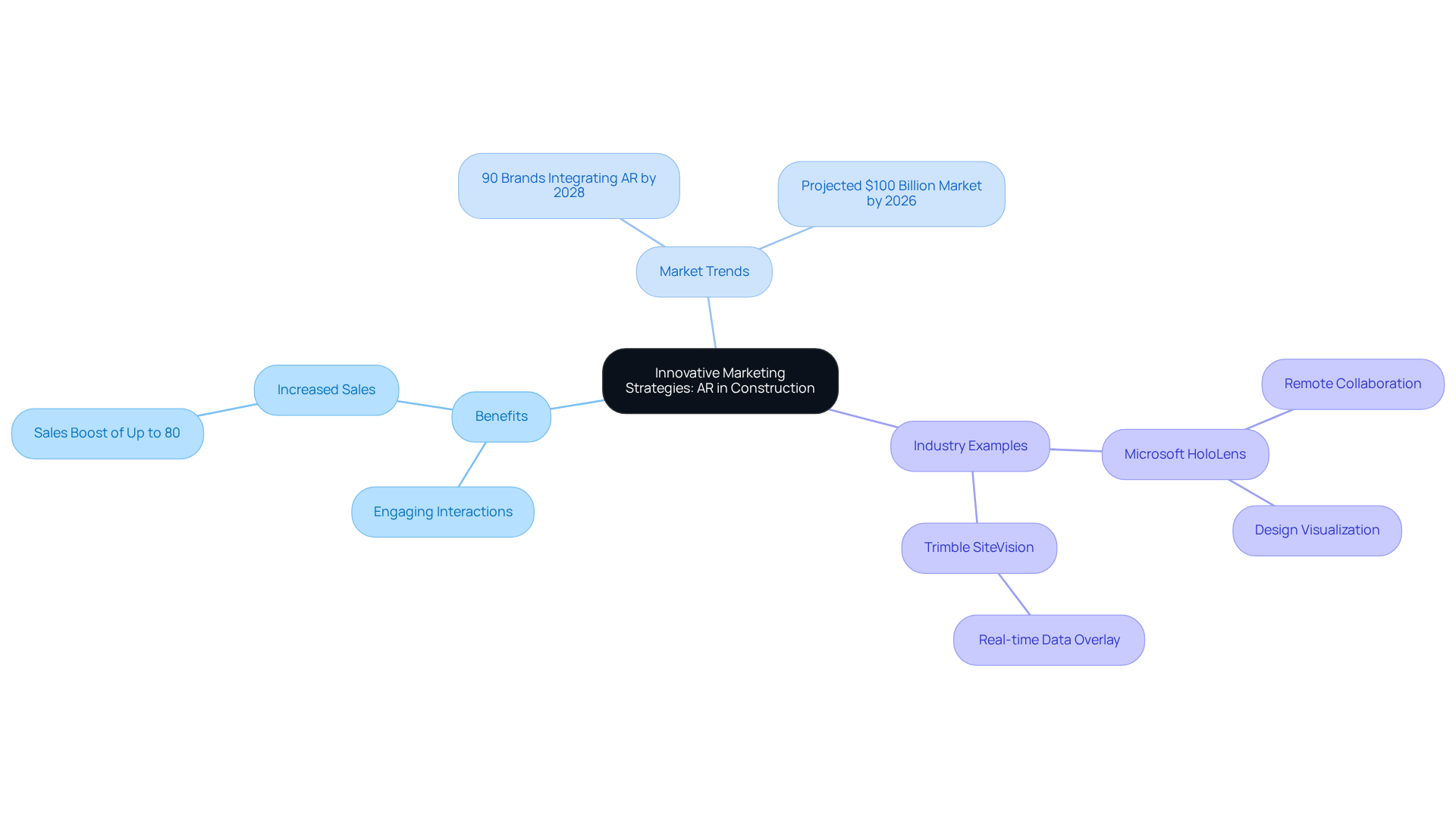
BIM Integration: Improving Project Accuracy with Augmented Reality
Combining Building Information Modeling (BIM) with construction AR fundamentally transforms how teams visualize data in real-time. This innovation significantly enhances precision and reduces mistakes. By superimposing BIM models onto physical job sites, teams can swiftly identify discrepancies between planned designs and the actual build, enabling timely adjustments. Such seamless integration streamlines workflows and ensures compliance with specifications, ultimately elevating overall quality.
As the building sector anticipates a construction AR market worth $150 billion by 2030, with enterprise AR projected to account for 65% of this construction AR market, the adoption of these technologies is becoming imperative for sustaining competitive advantage and fostering innovation. Furthermore, AR's capability to visualize hidden building elements aids maintenance teams in accurately pinpointing issues without resorting to destructive measures, thereby enhancing project outcomes and sustainability.
However, challenges such as data integration and limited device accessibility must be addressed to fully leverage construction AR's potential. Popular AR software tools like Microsoft HoloLens and Autodesk BIM 360 exemplify effective utilization of these technologies in the field. As Dmitry Tihonovich, Business Development Manager, states, "Enhanced safety can highlight potential hazards and guide workers through complex tasks, reducing the risk of accidents." This integration not only improves accuracy in initiatives but also aligns with the interests of e-commerce brand managers seeking to innovate in construction-related endeavors.
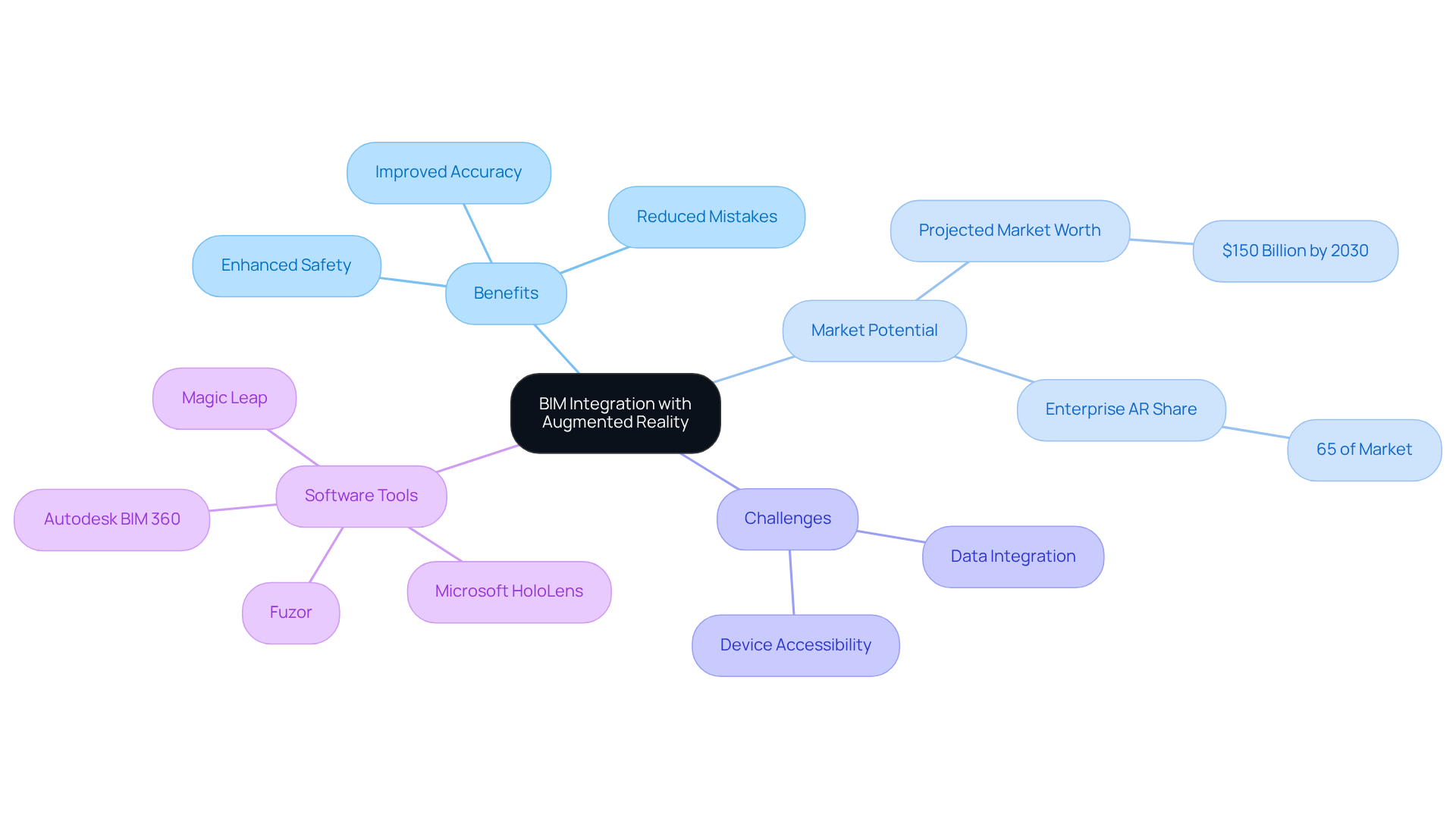
Future Trends: How Augmented Reality is Shaping the Construction Industry
Advancements in construction AR innovations are fundamentally transforming the building sector. As construction AR becomes increasingly accessible and cost-effective, its applications are positioned for dramatic expansion. Future trends indicate a substantial enhancement in collaboration through construction AR platforms, which enable teams to visualize and engage with data in real-time. This capability not only streamlines communication but also cultivates a more cohesive working environment.
Moreover, the integration of construction AR with other emerging technologies, such as artificial intelligence (AI) and the Internet of Things (IoT), is set to revolutionize the building processes. For instance, construction AR can overlay real-time data onto physical environments, assisting teams in making informed decisions and swiftly identifying on-site issues. This integration enhances project management efficiency and is projected to propel the AR development market from $0.3 billion in 2020 to $1.4 billion by 2025, reflecting a compound annual growth rate of 36.4%. Notably, 70% of building firms not currently utilizing construction AR plan to adopt it within the next three years, signaling a growing interest in these technologies.
In addition to improving collaboration, construction AR is increasingly utilized for training and security purposes. By simulating high-risk scenarios, AR allows laborers to practice precautionary measures in a controlled environment, significantly reducing the likelihood of accidents. Research indicates that construction AR can reduce errors by as much as 50%, highlighting its impact on safety and efficiency. This focus on safety is critical, as the building sector continues to prioritize worker well-being alongside operational effectiveness.
Magic Playbox, a leading XR studio, offers innovative solutions in construction AR that can enhance marketing strategies and client engagement within the building industry. By leveraging construction AR, building firms can create immersive presentations that showcase initiatives to prospective clients, thereby improving communication and understanding.
However, challenges such as cost, complexity, and data management persist as significant barriers to AR adoption. Addressing these obstacles will be essential for maximizing the benefits of AR in building.
As these advancements unfold, the building sector is likely to transition toward more innovative management practices, ultimately enhancing efficiency and safety throughout all phases of construction AR. For e-commerce brand managers, grasping these trends can inform marketing strategies and customer engagement initiatives, as the construction sector increasingly employs AR to elevate client interactions and project presentations.
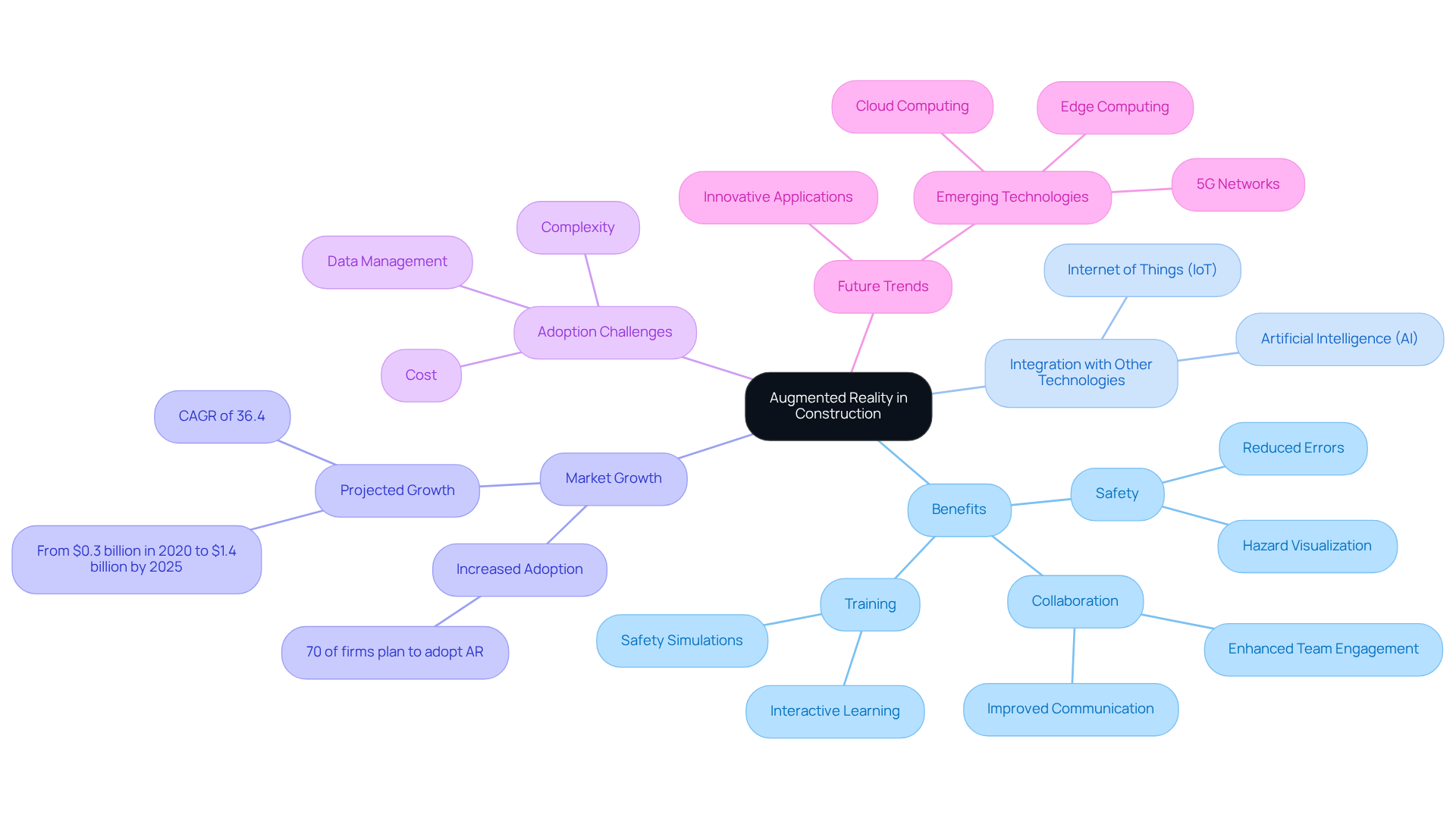
Conclusion
The integration of augmented reality (AR) in construction is not merely a trend; it is a transformative force reshaping the industry by significantly enhancing project efficiency and safety through innovative solutions. By enabling stakeholders to visualize complex designs and workflows in real-time, AR fosters improved communication and collaboration, effectively reducing costly errors and elevating overall project outcomes. This groundbreaking technology streamlines processes and empowers teams to make informed decisions, ultimately cultivating a construction environment that is both more efficient and safer.
Throughout this article, we have highlighted the key benefits of AR in construction, including:
- Real-time design visualization
- Enhanced on-site management
- Interactive safety training
- Improved stakeholder engagement
Each of these elements illustrates how AR contributes to increased efficiency, mitigated risks, and superior project management. The synergy of AR with Building Information Modeling (BIM) further underscores its potential to revolutionize construction operations, ensuring accuracy and compliance throughout the project lifecycle.
As the construction industry increasingly embraces AR technologies, it is imperative for firms to acknowledge the significance of these advancements in driving innovation and enhancing safety practices. By investing in AR solutions, organizations can bolster their operational capabilities and secure a competitive edge in a rapidly evolving market. The future of construction hinges on the successful integration of AR—now is the time to act.
Frequently Asked Questions
What is Magic Playbox and how does it enhance construction projects?
Magic Playbox is an immersive AR solution that transforms construction projects by providing real-time visualizations and interactive experiences. It helps stakeholders visualize complex designs and workflows, improving communication and teamwork, which reduces costly mistakes and boosts efficiency.
How has the use of AR impacted construction efficiency?
A builder named XYZ reported a 20% increase in efficiency after integrating AR into their communication processes. AR enhances collaboration and decreases the likelihood of errors, ultimately leading to improved project outcomes.
What role do digital twin systems play in construction AR?
Digital twin systems combined with AR allow for the creation of virtual replicas of physical assets, overlaying real-time data to enhance monitoring and decision-making throughout the project lifecycle.
What is the expected growth rate of the AR/VR market in construction?
The AR/VR market is projected to expand at a compound annual growth rate (CAGR) of 77% from 2019 to 2024, highlighting the importance of adopting immersive AR solutions in construction.
How does AR transform construction planning?
AR enables real-time design visualization by overlaying digital models onto physical job sites. This allows teams to see how designs fit within existing environments, facilitating better decision-making and immediate feedback, which helps identify potential issues early.
What technologies are commonly used in conjunction with construction AR?
Construction AR is often combined with Building Information Modeling (BIM) and tools like Microsoft HoloLens and Autodesk BIM 360 to enhance accuracy, efficiency, and workflow optimization.
How does AR improve on-site management in construction?
AR provides real-time data overlays, including timelines, resource allocations, and safety protocols, allowing managers to monitor progress and make informed decisions quickly, thereby reducing downtime and enhancing efficiency.
What safety benefits does AR offer in construction?
AR improves situational awareness by overlaying real-time hazard visualizations, which enhances safety and reduces risks on construction sites.
What challenges are associated with adopting AR in construction?
Challenges include significant upfront costs and the need for training, which may hinder the adoption of AR technology in construction operations.
How does AR contribute to reducing rework and saving project time?
By providing accurate visualizations and real-time data, AR minimizes the chances of errors and rework, leading to substantial time savings and more efficient project delivery.




